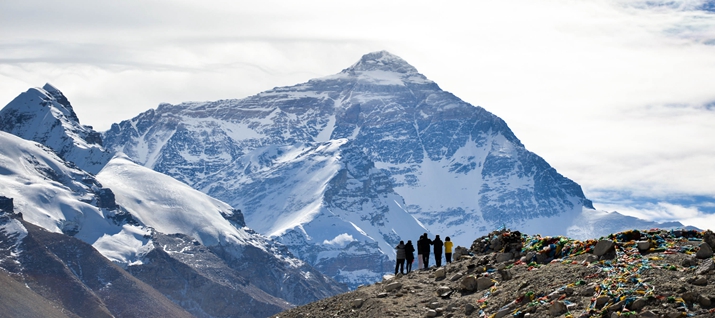Third Pole Challenges
Beijing Review by Yu Lintao, November 30, 2015 Adjust font size:
|
Mountain Qomolangma--known as Mount Everest in the West--towers 8,844.43 meters above sea level (XINHUA) |
As the globe's Third Pole, changes in the Tibetan Plateau's environment are closely linked to the evolution of the environment and ecosystem of the world, and Eurasia in particular.
The Hindu Kush-Himalayan region spans an area of more than 4.3 million square km in China, Afghanistan, Bangladesh, Bhutan, India, Myanmar, Nepal and Pakistan. The region stores more ice and snow than anywhere else in the world outside the polar regions, hence its name: The Third Pole. According to the International Center for Integrated Mountain Development (ICIMOD), the area contains the world's tallest mountains, including all 14 peaks above 8,000 meters, is the source of 10 major rivers, and forms a "formidable global ecological buffer."
However, a recent report on environmental change of the world's highest plateau published by the Institute of Tibetan Plateau Research (ITPR) under the Chinese Academy of Sciences (CAS) showed that as a result of global warming and human activity, the Tibetan Plateau is becoming both warmer and moister, and that natural disasters are on the rise.
Fortunately, the report also showed that despite dark projections for the long-term effects of climate change, the Tibetan Plateau remains one of the world's cleanest expanses.
A warming plateau
The environmental assessment report reviewed the changes on the Tibetan Plateau over the past 2,000 years and previewed its environment's evolution in the upcoming century. This was achieved through the efforts of more than 70 specialists from China, the United States, Sweden, Canada and several other contributors.
Data gathered by the report showed that the Tibetan Plateau has become more hot and humid, particularly over the past 50 years. The average annual temperature in the region rose by 0.3-0.4 degree Celsius every 10 years from 1960 to 2012, about twice the average of the rest of the world. The temperatures rose more sharply during the winter compared to historical averages, as well as in the northern part of the plateau.
Ice core records showed that temperatures in the region rose the most during the 20th century. According to climate change models, the next 100 years may see the plateau warming by up to 4 degrees Celsius.
Xu Baiqing, a researcher with the ITPR and an author of the report, said that high-altitude areas are more vulnerable to global warming, so it is worrying but not surprising that temperatures on the Tibetan Plateau rose faster than the global average. Worse yet, the rising temperatures across the plateau are accompanied by retreating glaciers, disappearing permafrost and increasing natural disasters.
According to the report, glaciers on the plateau have been decreasing in size since the 20th century due to rising temperatures, and at a faster rate since the 1990s. Glacier shrinkage in the plateau is the most prominent in the Himalayan Mountains and Southeast Tibet, whereas glaciers stay relatively stable, or are even growing, in the Karakoram and Western Kunlun region.
Due to glacial melting, both the number and area of the lakes on the Tibetan Plateau have increased notably. The number of lakes exceeding 1 square km climbed from 1,081 in the 1970s to 1,236 in 2010, and 80 percent of lakes in the region have been expanding.
ICIMOD's website states that "mountain systems are particularly sensitive to climate change and that the Third Pole region is home to some of the people most vulnerable to these changes in the world. Changes in the river systems and their basins have directly impacted on the wellbeing of millions of people."
Xu noted that against the backdrop of global warming, glacier loss is not unique to the Tibetan Plateau, but a common crisis that all plateaus are facing. Still, as ICIMOD has noted, as the rate of warming in the Third Pole region is significantly higher than the global average, and the rate is higher at higher altitudes, it suggests "a greater vulnerability of the cryosphere environment to climate change."
